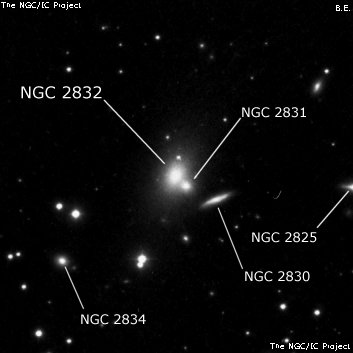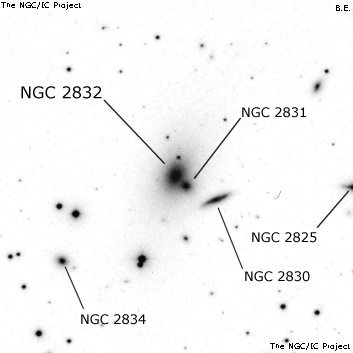NGC/IC Project Restoration Effort
(This is a very very beta version)
NGC2832


Basic Information
Location and Magnitude
Right Ascension: 9:19:46.8
Declination: +33:44:59
Constellation: LYN
Visual Magnitude: 11.9
Historic Information
Discoverer: Herschel W.
Year of discovery: 1785
Discovery aperture: 18.7
Observational
Summary description: F, vS, R, 3rd of 3
Sub-type: E2
Corwin's Notes
=====
NGC 2832 is the brightest galaxy in Abell 779, and was seen by WH and JH. The
younger Herschel also picked up another galaxy in the area, as did d'Arrest
-- who also saw three others, measuring two of them -- but it remained for
Lord Rosse's 72-inch Leviathan to reveal the cluster of a dozen or so galaxies
around the brightest. These are NGC 2823, 2825-2834, and 2839. Note that the
identification of NGC 2829 is somewhat uncertain, and that NGC 2827 = IC 2460
(which see).
Lord Rosse made micrometric measurements of only six of these (with respect
to the brightest), but JH received notes from the Earl that allowed him (JH)
to give good positions in the GC for six others. He had to give the remaining
two of the 15 claimed nebulae estimated positions.
In spite of JH's care, the GC is rather confused in the area. When Dreyer
came around to the group during his preparation of LdR's observations, he
sorted the area out pretty well, and the NGC reflects his careful work. In
the process, he dropped two of the GC numbers, and combined two others so that
the total number of nebulae here seen by LdR is just 12 -- the sketch shows
those twelve in their correct relative positions. Only for NGC 2829 (which
see) is there any uncertainty left about the identification.
Curiously, however, Dreyer put WH's observation and the brightest of JH's on
NGC 2830. LdR calls the brightest "alpha", and this is clearly the third of
three in short line in the center of the cluster. Yet Dreyer is apparently
claiming that WH and JH saw one of the fainter galaxies here, not the
brightest (Dreyer of course switches the descriptions as well). I find it odd
that, given his otherwise careful treatment of the area, he should have
misidentified the brightest galaxy, and not one of the fainter. However, his
note in the NGC gives an alternate (and correct) numbering of the galaxies,
showing that he was not convinced that he had it right in the main body of the
catalogue.
Finally, Dreyer has a note appended to the second of WH's catalogues of
nebulae for H I 113: "A second and better obs. in Sw. 549, Mar. 28, 1876, 40
Lyncis, p. 1m 11s, s. 39'." Reducing both this and the observation in WH's
main table shows that this is not a "better" observation, but is further off
in both coordinates than the presumeably "worse" one (09 16 40, +33 57.9 for
WH's first observation w.r.t. 66 Cancri; vs. 09 16 51, +33 57.5 for his
second. The modern position is 09 16 44.0, +33 57 43). In neither case,
however, is there any chance for mistaking the identification of WH's object
for anything but the brightest galaxy in the cluster.
Steve's Notes
=====
NGC 2832
17.5" (1/31/87): moderately bright, fairly small, round bright core, slightly elongated halo. This is the brightest galaxy in AGC 779 and forms a double system with NGC 2831 at the SW edge of halo 22" between centers. Also nearby is NGC 2830 1.3' SW. A double star h2493 = 10.1/11.7 is 2.5' SSE and a wide mag 11/12.5 pair is 3.0' ESE.
13" (1/28/84): fairly faint, fairly small, round. This object is the central galaxy in AGC 779.



